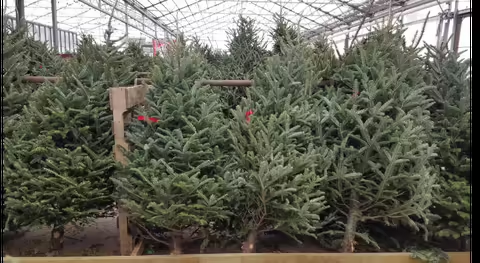Thanksgiving brings us a feast that, for many gardeners and naturalists, signifies the final harvest and close of the growing season. As we draw further away from the growing season and nearer to the winter solstice, many of us turn our focus to bringing light and greenery into our homes. Whether it is candles, twinkling lights, wreaths, garlands, or trees, these holiday traditions span centuries and cross many cultures.
For some, the largest and most anticipated addition of greenery is the Christmas tree. Whether it’s an artificial tree, a live cut tree, or a Norfolk Island Pine house plant (like in my home) we often give this wintertime symbol a prominent place in our home and gather around it to celebrate. When it comes to a live cut tree, we have a role to play in the selection and care of the tree to maximize its freshness and avoid sweeping up needles before our holiday season culminates.
Selecting a Christmas tree
I often get questions about which particular Christmas tree species is the best to select. All species grown for Christmas tree production have good needle holding character, so I place more value on the texture of the needles than any other species-specific characteristic.
- Pine and spruce species have sharp needles
- Fir species don’t have needle-sharp points to prick your finders while adding ornaments or brushing by the tree.
I prefer the shorter, stouter needles of fir for their less abrasive feel and their more coarse-textured appearance. Spruce have a similar, coarse appearance but do have a sharp needle. In contrast, pines typically have longer, thinner needles creating a more fine-textured appearance.
So, the question on species selection should probably be based on aesthetics over other factors.
holiday season.
When was the tree cut?
To me, the question of “when the tree was cut” is the most important factor to contemplate. Consider the fact that an evergreen tree has needles (or leaves) that continually draw moisture from its roots and the surrounding soil. Once the tree is separated from its roots, this process continues, which is why a cut tree requires a water source. Even with a water source on hand, the cut tree cannot take up enough water to support its needles indefinitely. So, the tree slowly dries out (or desiccates) over time, causing needles to drop as they lose moisture.
The minute your tree is cut, the clock begins ticking. Local retail outlets ship trees in from farms and these trees are not able to be shipped with a water supply and rarely receive water at retail locations. For the freshest cut trees, visit a local farm and do the shipping yourself.
Visiting a Christmas tree farm
A Christmas tree farm is a fantastic place to visit this time of year and I have fond memories of childhood connections to local farms. Since the trees are grown on-site, the time between being cut and being decorated in your living room is greatly reduced. You can also get some expert advice on transporting and caring for your tree from the folks who know them best, the farmers that grow them. Be sure to call ahead or check websites for hours of operation and additional safety precautions or distancing requirements this year.
Christmas tree care
Upon bringing your tree home, care and watering have the greatest impact on its longevity for the Holiday season.
The heat in our homes is a major factor in desiccation, so don’t bring the plant inside until it’s ready to be set up. Store plants outside, protected from wind with the cut end in a bucket of water. Also, place the tree indoors away from heat sources and vents if possible.
To maximize water uptake, it often pays to make a fresh cut 1 or 2 inches above the original cut, especially if you notice any excess of sap accumulation near the cut. Place the freshly cut stem in a tree stand that provides water. A 4-inch diameter tree can use up to 1 gallon of water per day, so be sure to leave an easy-access point for adding water. Check and water the tree daily to be sure the cut ends stays submerged at all times, which will prevent sap accumulation at the cut.
By following these care instructions, your tree will provide a season of enjoyment, bringing some much-needed greenery indoors for the holidays.
